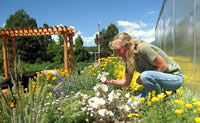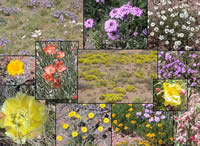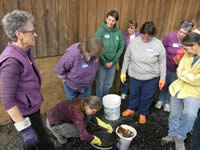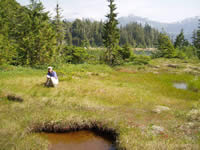Celebrating Wildflowers News 2010
December 2010
Rare Plant Discovery: Moonwort on the Shasta-Trinity National Forest - December 2010
A very rare plant has been found in northern California - one that is native to the West Coast but has not been found outside of Oregon before. This exciting discovery has several botanist on and around the Shasta-Trinity National Forest working to find and document the find.
October 2010
Botanists Call Them “Novelties” - October 2010
Botanists have been exploring North America for more than 250 years and they have found about 20,000 species of vascular plants. With that many plants, you would think botanists had found them all; but you would be wrong. About 40 new plant species are discovered each year in North America. Botanists call these new species “novelties” and the hope of finding new novelties keeps botanists exploring the remote nooks and crannies of North America year after year.
September 2010
O.N.Z.C.D.A. Awards their Gold Award to Celebrating Wildflowers
“O.N.Z.C.D.A. staff have completed assessments of Celebrating Wildflowers and it gives us immense pleasure to be able to award our Gold award this being issued on the date of 22/09/2010.
We congratulate you on the excellent work you presented to us, encourage you in your endeavors and we will look forwards to visiting your web site again in the future.”
“Dedicated to the enjoyment of the thousands of wildflowers growing in national forests and grasslands and to educating the public about the many values of native plants this site does not forget the children providing puzzles, coloring pages and fun activities! Many USDA Forest Service botanists and other specialists around the country have contributed to the editing, content, construction and maintenance of the site. Through their program Forest Service personnel and Celebrating Wildflowers partners and volunteers present informative talks, lead wildflower hikes, staff displays at public events such as flower and garden shows, write wildflower articles for the popular media and prepare and produce educational materials. A most relaxing site visit and one that is certainly worthy of bookmarking.”
Congratulations from O.N.Z.C.D.A Staff
August 2010
Mower Tract Ecological Restoration - West Virginia - August 2010
The Wes-Mon-Ty Resource Conservation and Development Project, Appalachian Plant Materials Center, and Monongahela National Forest have joined forces to restore watershed conditions and the native red spruce-northern hardwood ecosystem on surface mined land on Cheat Mountain. Through the use of native vegetation to reduce maintenance costs and increase the probability of success a restoration project and habitat improvement project has been implemented on the Mower Tract, which was surfacemined in the early 80s. The objective is to establish and restore native species of shrubs, trees, and herbaceous plants to this area with a short-term goal (5-20 years) of enhancing habitat for early successional species and a long-term goal of spruce ecosystem restoration. The primary plant species targeted to use for long term restoration efforts include, but are not limited to: speckled alder, bigtooth aspen, balsam fir, and red spruce.
July 2010
Native Treasures: Forest Service propagates, showcases plants - July 2, 2010
 Fragrant evening primrose is a favorite of Forest Service botanist Twyla Miller. Photo by Laura Christman, Record Searchlight.
Fragrant evening primrose is a favorite of Forest Service botanist Twyla Miller. Photo by Laura Christman, Record Searchlight.
Deep in the woods, high on mountains and along meadows, seeds are gathered and cuttings snipped. These botanical beginnings are taken to an 18-by-36-foot greenhouse in Mount Shasta and coaxed to life. Which isn't always easy — native plants can be rather demanding about sprouting. Some like sandy, rocky soils; others prefer loamy, duffy dirt. Some seeds insist on a period of cold moistness, others require six months of dryness.
May 2010
Purple Is to Dye For - Spring 2010
Since before medieval times, lichens have been used to dye wool and other natural fibers in many cultures around the world. Specific lichens produce a rainbow of permanent colors on all types of fibers, producing shades of red, gold, brown, yellow and purple. This ancient but still thriving craft was introduced to Alaska fiber artists through workshops held in 2009 during the Cordova Fungus Festival in Cordova and the Tongass Rainforest Festival in Petersburg. Participants learned the history, technique and sustainable collection practices of lichens for their use as natural dyes.
Prince William Sound Zone: Shoreline Rare Plant Surveys - Spring 2010
Prince William Sound (PWS), Alaska is known worldwide for its amazing wildlife and scenery, but the wide varieties of plants that inhabit this area are little understood. Past surveys have documented numerous sensitive and rare plant species on South central Alaskan maritime shorelines. Prior to this survey, little was known of the presence or distribution of several sensitive plant species that are known to occur in similar habitats as found in PWS. The PWS area is managed to maintain its wild character and unique wildlife habitat. Although human access is generally limited to boat or aircraft, recreational and other human uses are continuing to increase.
Art Gallery to Showcase Paintings of Former Loda Lake Resident Artist - May 13, 2010
On Tuesday evening, May 18th, the Michigan Garden Clubs, together with the Huron-Manistee National Forests, will be hosting the opening display of the Midwestern paintings by Albert Schmidt, former resident artist at what is now the Loda Lake Wildflower Sanctuary.
March 2010
Spectacular Wildflower Displays Expected in the Southwest in the Spring of 2010

Abundant rainfall fell throughout much of the Southwest during the winter of 2009/2010. We expect this to produce spectacular spring wildflower displays. Spring wildflowers, mostly annuals, will start blooming in the low deserts in early March, with peak blooming in April and early May at higher elevations.
Monarchs in Space: The Return - March 12, 2010
Monarchs were sent into space via the shuttle Atlantis on the 16th of November 2009 to be delivered to the International Space Station (ISS) where they lived out their lives. These monarchs are now back in Kansas and will become part of a permanent display at Monarch Watch.
January 2010
Monarchs in Space - January 2010
When the space shuttle Atlantis blasted off from Kennedy Space Center's Launch Pad 39A, on November 16, 2009, three monarch caterpillars from Monarch Watch, were on board headed to the International Space Station (ISS).
Read more about Monarchs in Space…
MonarchLIVE, A Distance Learning Adventure - Update January 2010
Staff from the Forest Service International Programs worked with staff from Prince William Network (PWN) schools located in Virginia, and the Forest Service Washington Office of Conservation Education to implement "Monarch Live, A Distance Learning Adventure". This project was in the planning stages for almost two years and the implementation took place during fiscal year 2009 over a seven-month period. The project included over 25 partners in the United States, Mexico, and Canada.







